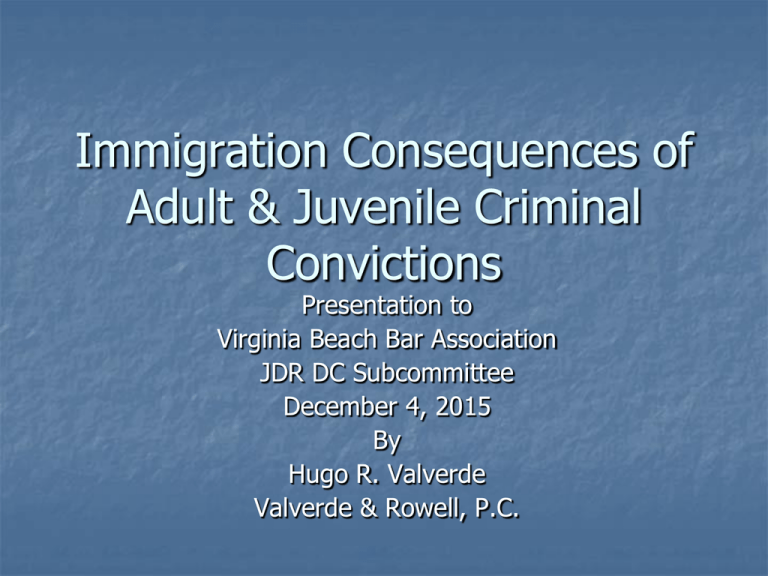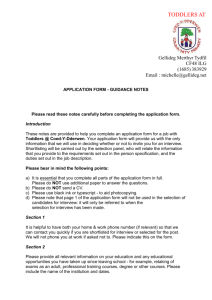to Immigration Power Point
advertisement

Immigration Consequences of Adult & Juvenile Criminal Convictions Presentation to Virginia Beach Bar Association JDR DC Subcommittee December 4, 2015 By Hugo R. Valverde Valverde & Rowell, P.C. Who is a U.S. Citizen? Born on U.S. soil or U.S. territories 14th Amendment - All persons born or naturalized in the United States, and subject to the jurisdiction thereof, are citizens of the United States and of the State wherein they reside. U.S. v. Wong Kim Ark, 169 U.S. 649 (1898) Naturalized (formerly had a green card, took the oath of citizenship) Who is a U.S. Citizen? Born to U.S. citizen parent(s) abroad or sometimes grandparent(s) Has green card and while under the age of 18, parent(s) became U.S. citizen Generally, once a U.S. citizen always a U.S. citizen and cannot be deported. Inadmissibility v. Removability A criminal conviction makes a non-citizen deportable or ineligible for an immigration benefit b/c he is “inadmissible” or “removable.” A non-citizen is “inadmissible” when he/she has not been formally inspected at a port of entry or seeks a visa or lawful permanent residence. INA § 212 applies. A non-citizen is “removable” if he/she has been inspected and entered under a legal visa. INA § 237 applies. “Conviction” A formal judgment of guilt by a court OR If adjudication of guilt has been withheld (i.e. no judgment of conviction entered) there is Guilty plea or plea of nolo contendere; Admission of sufficient facts; OR Judge or jury has found guilt; AND Judge has ordered some kind of punishment, penalty, or restraint on liberty INA § 101(a)(48)(A); 8 U.S.C. § 1101(a)(48)(A) “some kind of punishment, penalty, or restraint” can be probation Convictions on appeal by right are not “convictions” because not final. Example conviction on appeal from General District Court to Circuit Court not a “conviction.” Tips for Defense Attorneys Deferred adjudications Avoid pleading guilty or finding of guilty in the warrant/record. Otherwise will still be considered a “conviction” under immigration law. Still may not be enough because First Offender provisions in Va. Code state: “. . . if the facts found by the court would justify a finding of guilt . . .” Examples: Va. Code § 18.2-251 (marijuana possession) and § 18.2-57.2 (domestic assault) “Sentence” Includes the period of incarceration or confinement ordered by a court regardless of any suspension in whole or in part. INA § 101(a)(48)(B); 8 U.S.C. § 1101(a)(48)(B). Juvenile Convictions Convictions of minors in juvenile and domestic relations court are not convictions for immigration purposes. Matter of Devison, 22 I&N Dec. 1622 (BIA 2000). However, if juvenile transferred to adult court then it is a conviction. Note: Sometimes Adverse Immigration Consequences Do Not Require Convictions Some grounds of inadmissibility/removability do not require a “conviction” to trigger adverse immigration consequences: Drug trafficking (i.e. drug dealing) Drug abuser or drug addict Prostitution Violations of protective orders False claim to U.S. Citizenship Also… Many immigration benefits are discretionary The government can still use its discretion to deny immigration benefits even though juvenile convictions may not be “convictions.” Crimmigration Consequences Deportation Mandatory Detention by Immigration with no bond Ineligibility for U.S. citizenship Ineligibility for a “green card” and immigrant and non-immigrant visas Eligibility for relief from deportation or waivers Possible lifetime separation from family and friends Mandatory Immigration Detention Under INA § 236(c) Immigration Judge cannot grant bond if defendant has been convicted of certain crimes Controlled substance violations Crimes involving moral turpitude Aggravated felonies Firearms offenses Drug Offenses Almost any drug offense makes a person inadmissible or removable, regardless of sentence. For inadmissibility (someone applying for a visa abroad or applying for permanent residence in the U.S.), a conviction is not necessary Can be an admission to an officer that he has committed an act that is punishable under any law relating to a controlled substance. INA § 212(a)(2)(A)(i)(II). Officer can have “reason to believe” that non-citizen has been involved in drug trafficking. INA § 212(a)(2)(C)(i). Drug Offenses For removability, any non-citizen who after admission is convicted of violating (or conspiracy or attempt to violate) any law relating to a “controlled substance.” INA § 237(a)(2)(B)(i). Even possession of drug paraphernalia could be a crime relating to a controlled substance if relates to a substance listed in the federal schedule. See Mellouli v. Lynch, ___ U.S. ____, No. 13-1034 (June 1, 2015); Matter of PachecoVentura (unpublished BIA decision 2003). Drug Offenses Not removable for a drug conviction if only a single offense for marijuana possession of 30 grams or less. INA § 237(a)(2)(B)(i). Tip: Try to get the amount in the record if less than 30 grams. Not inadmissible or removable if conviction does not relate to a federally “controlled substance” as defined in 18 U.S.C. § 102. Mellouli v. Lynch, ___ U.S. ____, No. 13-1034 (June 1, 2015); Matter of Paulus, 11 I&N Dec. 211 (BIA 1965). Drug Offenses Consequences: Denied entry from abroad Denied changing to another type of visa Never become a lawful permanent resident, unless for possession of 30g or less of marijuana Denied U.S. Citizenship Placed in removal proceedings and subject to mandatory detention NOTE: Some drug offenses are “aggravated felonies” Aggravated Felonies Don’t let the name fool you – a misdemeanor under state law can still be an aggravated felony. Not all aggravated felonies have one year sentence triggers Can be “kiss of death” for a non-citizen Only applies to removability – non-citizens who have been inspected and entered under a legal visa INA § 101(a)(43) defines 19 types of aggravated felonies Aggravated Felonies Rape, murder, and sexual abuse of a minor Sexual abuse of a minor does not require contact. Indecent exposure enough. Matter of RodriguezRodriguez, 22 I&N Dec. 991 (BIA 1999). Solicitation of minor. Gattem v. Gonzalez, 412 F.3d 758 (7th Cir. 2005) (Illinois conviction of misdemeanor solicitation to engage in a sexual act is sexual abuse of a minor where criminal complaint (and no other document) showed victim under the age of 18) Solicitation of undercover adult officer posing as child on internet. Hernandez-Alvarez v. Gonzales, 432 F.3d 763 (7th Cir. 2005) Aggravated Felonies Illicit trafficking in a controlled substance, including a “drug trafficking crime” defined in 18 USC § 924(c) Any drug conviction where the statute has an element of sale or distribution, regardless of sentence could be an aggravated felony. Any federal conviction for possession that is a felony BUT state felony possession that would not be a felony under federal law NOT an ag felon, Lopez v. Gonzalez, 125 S. Ct. 625 (2006) unless for flunitrazepam (date rape) or >5g of crack. A second possession conviction may be an ag felony if it would be a felony under federal statute as repeat offender PWID marijuana not ag felony if statute covers sharing of a small amount of marijuana with no renumeration, e.g. Va. Code § 18.2-248.1(a). Moncreiffe v. Holder, 133 S.Ct. 1678 (2013). Aggravated Felonies Crime of violence and sentenced to at least one year imprisonment Defined in 18 USC § 16 (a) Element of the use, attempted use, or threatened use of force against person or property or (b) A felony that involved a substantial risk that force will be used in commission of offense Must involve active force and a higher degree of intent than mere negligent or accidental conduct. Leocal v. Ashcroft, 543 U.S. 1 (2004). Look at statute of conviction for required mental state Aggravated Felonies Not Crimes of Violence Simple involuntary manslaughter under Va. Code § 18.2-36. Bejerano-Urrutia v. Gonzalez, 413 F.3d 444 (4th Cir. 2005). DUI and DUI causing bodily injury. Leocal v. Ashcroft. Assault recklessly causing serious physical injury by means of deadly weapon or dangerous instrument. Garcia v. Gonzalez, (4th Cir. 2006). Va. domestic violence not categorically a COV. Matter of Velasquez, 25 I&N Dec., 278 (2010) Crimes of Violence Misdemeanor sexual battery under § 18.2-67.4. Wireko v. Reno, 211 F.3d 833 (4th Cir. 2000). Aggravated Felonies Theft or burglary offense for which term of imprisonment at least one year Fourth Circuit said Virginia grand larceny conviction is not an aggravated felony theft offense. Omargharib v Holder, 775 F.3d 192 (2014). Note: It can still be a CIMT. Child pornography Owning/managing prostitution business/human trafficking Obstruction of justice/perjury Attempt or conspiracy to commit any of the enumerated aggravated felonies AND SEVERAL MORE . . . Aggravated Felonies Consequences Mandatory detention Certain deportation Not eligible for any relief from deportation, except deferral of removal under Convention Against Torture Permanent bar from ever being able to return, unless get a special waiver. Permanent bar to U.S. citizenship Crimes Involving Moral Turpitude (“CIMTs”) For inadmissibility (person applying for visa outside the U.S. or permanent residence in the U.S.), one CIMT or an attempt or conspiracy to commit a CIMT Exceptions: Crime committed under 18 and 5 years (from release from confinement) prior to date of application or admission Max penalty of crime one year or less and actually sentenced to 6 months or less (“petty offense exception”) For removability, One CIMT within 5 years of admission and sentence one year or more may be imposed Two CIMTs not arising out of a single scheme of criminal misconduct regardless of sentence or imprisonment CIMTs Defined by case law not statute “A nebulous concept, which refers generally to conduct that shocks the public conscience as being inherently base, vile, or depraved, contrary to the rules of morality . . . .” Matter of Danesh, 19 I&N Dec. 669 (BIA 1988). Does not matter whether a felony or misdemeanor Start by looking at the elements required for conviction CIMTs Test: Does the statute contain an element reflecting “a vicious motive or corrupt mind?” Matter of Franklin, 20 I&N Dec. 867 (BIA 1994). CIMTs Simple assault and battery usually not CIMT. Matter of Fualauu, 21 I&N Dec. 475 (BIA 1996). However, assault with aggravating circumstances is can be a CIMT, e.g. police officer, deadly weapon, injury to family member. Possession of firearm not CIMT. Matter of Granados, 16 I&N Dec. 726 (BIA 1979). However, use of a firearm under Va. Code 18.2-53.1 is a CIMT. United States v. Brown, 127 F.Supp.2d 392 (WDNY 2001). Theft offenses are CIMTs – intent to deprive owner Maybe Va. 46.2-894 -failure to stop after accident Also Not CIMTs Va. 18.2-102 (joyriding) Va. 18.2-89 (burglary, where record reflects that B&E was not done with intent to commit CIMT – ie. B&E with intent to trespass) DUI and motor vehicle offenses Va. 18.2-266 (DUI) Va. 46.2-862 (reckless driving) CIMTs False Pretenses/Fraud is CIMT– intent to defraud Burglary and robbery are CIMTS – intent to commit a felony or steal. United States v. Brown, 127 F.Supp.2d 392 (WDNY 2001). False police report is a CIMT – intent to mislead Sex offenses are CIMTs Controlled substance offenses with an intent or knowledge of manufacture or distribution a CIMT. Matter of Khourn, 21 I&N Dec. 1041 (BIA 1997). Consequences of CIMTs Denied a visa and lawful permanent residence, unless “petty offense” exception or waiver is available Denied U.S. Citizenship if within 5 years of application and may be placed in deportation proceedings Mandatory detention upon arriving/reentry into the U.S. and placed in deportation proceedings Still eligible for some forms of relief from deportation Domestic Violence Removable for domestic violence, stalking, child abuse, child neglect, or child abandonment conviction. INA § 237(a)(2)(E)(i). “Crime of domestic violence” is any crime of violence defined in 18 U.S.C. § 16 against a person by a current or former spouse, individual w/ a child in common, cohabiting or cohabited with person as a spouse, individual similarly situated as a spouse under the state law, or any individual against a person protected by federal, state, or local domestic violence laws. Id. Domestic Violence Removable for violation of protective order that protects against credible threats of violence, repeated harassment, or bodily injury. § 237(a)(2)(E)(ii). Domestic violence conviction is not categorically a CIMT. Matter of Sejas, 24 I&N Dec. 246 (BIA 2007). Not categorically a crime of domestic violence or crime of violence ag felony if sentenced to one year or more. Matter of Velasquez, 25 I&N Dec. (BIA 2010) Consequences of Domestic Violence Conviction Not a ground of inadmissibility (person applying for a visa outside U.S. or permanent residence in U.S.), unless a CIMT. A ground of removability and may be placed in removal proceedings Denial of U.S. Citizenship and may be placed in removal proceedings Not subject to mandatory detention, unless a CIMT or an agg felon Still eligible for waivers of inadmissibility or removal, unless an agg felon Firearms Offenses Removable for conviction of purchasing, selling, offering for sale, exchanging, using, owning, possessing, or carrying (or attempt or conspiracy) a firearm or destructive device. INA § 237(a)(2)(C). Firearm defined in 18 U.S.C. § 921(a). Statute of conviction must specify a firearm is involved. Matter of Perez-Contreras, 20 I&N Dec. 615 (BIA 1992). Consequences of Firearms Offenses Not a ground of inadmissibility, unless a CIMT. Depends on severity and intent. A ground of removability and may be placed in removal proceedings Will not be denied U.S. Citizenship, unless a CIMT or agg felon Subject to mandatory detention Still eligible for waivers of inadmissibility or removal, unless an agg felon Categorical Approach Strict categorical approach to determine whether conviction triggers immigration consequences. Descamps v. United States, 133 S.Ct. 2276 (2013); Mellouli v. Lynch, ___ U.S. ____, No. 13-1034 (June 1, 2015). First look at the language of the federal/state statute of conviction taken at its minimum and see whether it matches a ground of inadmissibility or removability. The actual conduct leading to the conviction is irrelevant. Look to see whether all the conduct criminalized under the statute fits a ground of inadmissibility or removability. Modified Categorical Approach When the statute of conviction defines more than one offense, the categorical analysis cannot be performed until it is determined which of the offenses the individual was convicted of. The court can look at the “record of conviction” - consists of charging document, indictment, information, plea, verdict, and sentence not police report. Matter of Teixeira, 21 I&N Dec. 316 (BIA 1996) Defense Strategies Negotiate sentence under one year (if that Matters for immigration): Waive credit for time served Have client spend more time in jail instead of having suspended sentence over one year Have client serve more straight probation Defense Strategies To the extent practicable ensure that the record does not reflect an inadmissible/ deportable offense – what’s in the record: Charging document Official record of judgment and conviction Official record of plea (including transcript) Official record of verdict Official record of sentence Defense Strategies Modify the record of conviction – ask the prosecutor to issue new charging document Example: Va. 18.2-89 is not a CIMT unless the record reflects B&E with intent to commit a CIMT; ask prosecutor to amend charge to B&E with intent to commit trespass Plead to a another offense that does not trigger adverse consequences. Vacating a “Conviction” For conviction to be vacated for immigration purposes it must be vacated on basis of substantive or procedural defect NOT for rehabilitative purposes or to ease immigration hardships. Matter of Pickering, 23 I&N Dec. 621 (BIA 2003) Substantive or procedural defect must have existed at the time of conviction Vacating a “Conviction” Motion to vacate conviction must be based on legal defect existing at time of conviction E.g. motion to withdraw guilty plea, motion to vacate conviction, habeas corpus, coram nobis, audita querela Coram nobis and audita querela limited in Virginia. Commonwealth v. Morris, 281 Va. 20 (2011) Record should not indicate that it was vacated to avoid adverse immigration consequences. However, if state has advisal statute can use that as valid ground to vacate conviction. Matter of Adamiak, 23 I&N Dec. 878 (BIA 2006). VA does not have a formal advisal statute. Modifying a “Sentence” Court decision to reduce a sentence nunc pro tunc to less than one year is given full faith and credit by the immigration courts, even if it is to avoid adverse immigration consequences. Matter of Cota-Vargas, 23 I&N Dec. 849 (BIA 2005). Could also use to qualify conviction for “petty offense exception” E.g. Commonwealth v. Mohamed, 71 Va. Cir. 383 (Arlington County 2006). Pardons Full and unconditional pardons from the governor will remove crimmigration consequences. In Virginia it must be an “absolute pardon.” Simple or conditional pardon not enough. Padilla v. Kentucky, 559 U.S. 356 (2010) Ineffective Assistance of Counsel - Should defense counsel advise defendant of possible adverse immigration consequences if they plead guilty? Supreme Court held yes if upon reading of immigration statute it is fairly succinct and straightforward that client will face deportation. If not succinct and straightforward, then only warning of possibility of deportation sufficient. Zemene v. Clark, 768 S.E.2d 684 (Va. 2015) Defense attorney’s performance fell below Strickland standard because failed to: Learn the “precise nature” of client’s immigration status Determine “potential negative consequences” relative to immigration status under plea Broach subject of immigration consequences to Commonwealth Attorney in plea negotiations Discuss with client likelihood of immigration consequences of plea Virginia Justice Project Updated immigration consequences of Virginia criminal convictions by Capitol Area Immigrant’ Rights Coalition at http://www.caircoalition.org/what-wedo/vjp/vjp-immigration-consequencesresources/ Questions? Hugo Valverde 757-422-8472 hugo@valverderowell.com





